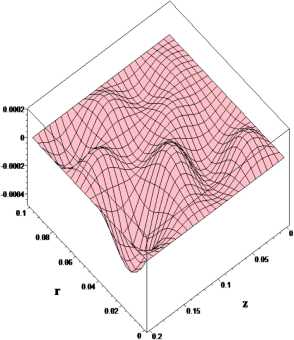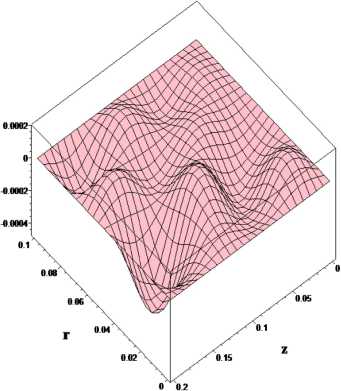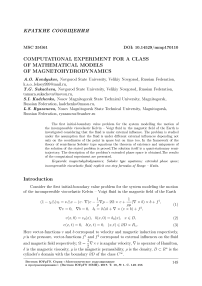Computational experiment for a class of mathematical models of magnetohydrodynamics
Автор: Kondyukov A.O., Sukacheva T.G., Kadchenko S.I., Ryazanova L.S.
Рубрика: Краткие сообщения
Статья в выпуске: 1 т.10, 2017 года.
Бесплатный доступ
The first initial-boundary value problem for the system modelling the motion of the incompressible viscoelastic Kelvin - Voigt fluid in the magnetic field of the Earth is investigated considering that the fluid is under external influence. The problem is studied under the assumption that the fluid is under different external influences depending not only on the coordinates of the point in space but on time too. In the framework of the theory of semi-linear Sobolev type equations the theorem of existence and uniqueness of the solution of the stated problem is proved. The solution itself is a quasi-stationary semi-trajectory. The description of the problem's extended phase space is obtained. The results of the computainal experiment are presented.
Magnetohydrodynamics, sobolev type equations, extended phase space, incompressible viscoelastic fluid, explicit one-step formulas of runge - kutta
Короткий адрес: https://sciup.org/147159408
IDR: 147159408 | УДК: 517.9 | DOI: 10.14529/mmp170110
Текст краткого сообщения Computational experiment for a class of mathematical models of magnetohydrodynamics
Consider the first initial-boundary value problem for the system modeling the motion of the incompressible viscoelastic Kelvin - Voigt fluid in the magnetic field of the Earth
(1 — xA ) v t = vAv — ( v • V ) v
Vv = 0 , Vb = 0 ,
— 1 Vp — 2О x v + —( V x b ) x b + f 1 , ρ ρµ
bt = 5 Ab + V x ( v x b ) + f 2 ,
v ( x, 0) = v 0( x ) , b ( x, 0) = b 0( x ) , x E D, (2)
v ( x, t ) = 0 , b ( x,t ) = 0 , ( x,t ) E dD x R + . (3)
Here vector-functions v and b correspond to velocity and magnetic induction respectively, p is the pressure, vector-functions f 1 and f 2 correspond to external influences on the fluid 1
and magnetic field respectively; О = ^ V x v is angular velocity, V is operator of Hamilton, 5 is the magnetic viscosity, у is the magnetic permeability, p is the density. D C Rn is the cylinder’s domain with the boundary dD of the class C A
This work continues investigations of magnetohydrodynamics models which were started by the authors in [2,3]. Its distinctive feature is that there are vector-functions f k = ( f i k . f 2 ...., f n ) in the right part of equations (1).
The first initial-boundary value problem (1) - (3) is reduced to an abstract Cauchy problem for a semi-linear non-autonomous Sobolev type equation. On the base of the solvability theory of the indicated problem the theorem of existence and uniqueness of the solution of the stated problem is proved. The solution itself is a quasi-stationary semitrajectory. The description of the problem’s extended phase space is obtained. The results of the computational experiment are represented. The results of part 1 are taken from [4], the results of part 2 are obtained on the base of the results [2]. During the computational experiment the methods of solution of the initial-boundary problem (1) - (3) are used. They were described in [3]. Also we used the software package [5].
1. Semi-Linear Non-Autonomous Sobolev Type Equations
Consider the Cauchy problem for the semi-linear non-stationary Sobolev-type equation u (0) = u 0, Lui = Mu + F (u) + f (t).
Here the operator L E L ( U ; F ) , i.e. it is linear a nd continuous, ker L = { 0 } ; the operator M : dom M ^ F is linear and closed and it is densely defined in U, i.e. M E Cl ( U ; F ); U and F are Banach spaces. Let U M be the lineal dom M equipped with the norm of the graph || | • ||| = || M • Ц^ - + || • ||M. We assume that F E C~ ( UM ; F ) , and the function f E C ~ (R +; F ) .
Consider (4) under condition that the operator M is strongly ( L,p )-sectorial [4]. It is well known that in this case a solution of this problem exists not for all u 0 E U M , and even if it exists it may be non-unique. So we introduce two definitions: the extended phase space and quasi-stationary semi-trajectory.
It is well known that if the operator M is strongly ( L,p )-sectorial, then U = U 0 • U 1 , F = F 0 ^F 1 , where
U0 = {ф EU : U tф = 0 3t E R+}, F0 = {0 EF : Ft 0 = 0 3t E R+} are the kernels, and
U 1 = {u EU : lim U t u = u}, t → 0+
F 1 = {f EF : t l i m F t f = f}
are
Ft
the images of the analytic solving semigroups U t
= 2 П- у L L ( M ) е-Мц (Г C S La ( M )
A [ RL ( M ) d 2 ni
Γ
is a contour such that arg ц ^ ± 0 when
Γ
|ц| ^ + to) of the linear hornogeneous equation Li = Mu. Let L k ( M k ) Ire a restriction of the operator L ( M ) оn Uk ( Uk П dom M ) , k = 0 , 1 . Then L k : Uk ^ Fk, M k : Uk П dom M ^ Fk, k = 0 , 1; and restrictions M 0 arid L 1 of the оperators M
and L on the spaces U 0 П dom M and U 1 respectively are linear continuous operators and
they have bounded inverse operators.
So we reduce (4) to
Rui0 = n 0 + G (n) + g (t), n 0 (0) = n о, u1 = Su1 + H (u) + h (t), u1 (o) = u 0, where uk E Uk, k = 0,1, u = u0 + u1, operators R = M0 1Lо, S = L01M0, G = M-1 (I — Q) F, H = L -1QF, g = M3" 1( I— Q) f, h = L -1 Qf. Here Q EL (F)(= L (F; F)) is the corresponding projector.
We study such quasi-stationary semi-trajectories of (4), for which Rui 0 = 0 . Assume that the operator R is bisplitting . i.e. its kernel ker R and image im R are complemented In the space U. Deirote U 00 = ker R, arid U 01 = U 0 OU 00 is a complement of the subspace U 00 . Then the Erst equation of (5) Is reduced to the form Ru t01 = u 00 + u 01 + G ( u ) + g ( t ) , where u = u 00 + u 01 + u 1 .
Theorem 1. Let the operator M be strongly ( L,p)-sectorial, and the operator R be bisplitting. Let there exist a quasi-stationary semi-trajectory u = u ( t ) of equation (4). Then it satisfies the following relations
0 = u 00 + u 01 + G ( u ) + g ( t ) , u 01 = const .
It is known that if the operator M is strongly ( L,p )-sectorial then the operator S is sectorial. So it generates an analytic semigroup on U 1. Denote it as {Ut : t > 0 } because the operator Ut In fact Is a restrict Ion of the operator Ut о n U 1 . The fa, ct that U = U 0 • U 1 shows that there exists a projector P E L ( U ) corresponding to this splitting. It can be shown that P E L ( UM ) . Then tlre space UM splits Into the direct sum UM = UM ■ UM so that the embedding UM C Uk, k = 0 , 1 Is dense and continuous. Symbol Av denotes the Frechet derivative at v eV of the о perator A, defined on som.e Banach space V.
Theorem 2. Let the operator M be strongly ( L,p)-sectorial, the operator R be the bisplitting one, the operator F E C^ ( UM ; F ) , the vector-function f E Cю (R+; F ) . Let the following conditions be satisfied:
-
(i) 0 = u 01 + ( I — PR )( G ( u 00 + u 01 + u 1) + g ( t )) in the neighborhood Ou 0 C UM of the point u 0:
-
(ii) the projector PR E L ( UMM ) , and the operator I + PRG'u 0 : UM ^ UMM is the topological linear isomorphism ( U °° = UM AU 00);
τ
(iii) / IIUt^n (U1; U1) dt< ^^T E R+' 0 M
2. The Existence of the Unique Solution
Then there exists a unique solution of (4), which is a quasi-stationary semi-trajectory of equation (4).
Now let Uk arid Fk Ire Banach sprices, operators Ak E L ( Uk, Fk ) , arid operators Bk : dom Bk ^ F be linear and closed with domains dom Bk dense In Uk, k = 1 , 2 . Construct spaces U = U 1 x U 2 , F = F i x F 2 and operators L = A 1 ® A 2 , M = B 1 ® B 2 . By construction operator L E L ( U ; F ) , and operator M : dom M ^ F is linear, closed and densely defined. In U dom M = dom B 1 x dom B 2 .
Theorem 3. Let the operators Bk be str ongly ( Ak ,pk )-secto rial, k = 1 , 2; a nd p 1 > p 2 . Then the. operator M is sti"ongly ( L,p^-sectorial.
Following [2] consider problem (2), (3) for system (1) transformed to the form
(1 — xA ) vt = v Av — ( v • V ) v —
- Vp — 2Q x v + —( V x b ) x b + f ρ ρµ
V ( V- v )=0 , V ( V- b )=0 , bt = 6 Ab + Vx ( v x b ) + f 2 .
Then similarly to [2] we introduce the spaces U and F the operators L and M generated by the problem (2). (3) for the transformed system (1). Strong ( L, 1)-sectorialness of the operator M under the assumption \ 1 / ° ( A ) , A = V 2 En EF is identity n x n matrix) is established using the Theorem 3. The form of the nonlinear operator F is similar to the one in [2], only the first and the second elements of the vectorcolumn include the term f 1, and the last element includes f 2. Belonging of F to the class Cю ( U m ; F ) is proved by calculation of the Frechet derivatives of this operator. Therefore, all assumptions of Theorem 1 and Theorem 2 are satisfied. Consequently, the following result holds.
Theorem 4. 7/ к - 1 / ° ( A ) U о (_ L) , ^ten for all u 0 G M and some T E R+ there exists a unique solution u = ( uCT, 0 , up,ub ) of (1) - (3) which is a quasi-stationary trajectory. Moreover, u ( t ) G M .for all t G (0 , T ).
Here ACT is a restriction of the operator A on the corresponding subspace of solenoidal vectors. uCT, 0 , up,ub are the elements of the correspoiiding subspaces of Banach space U [2]: M is the extended phase space of (1), (3), which has the following form
M = {u G UM : un = 0 ,bn = 0 , up = П( vACT — ( uCT • V ) uCT— 2fi x uCT + ( V x ba ) x ba + f 1) }.
3. Computational Experiment
Introduce a cylindrical coordinate system ( r, ф, z ) with center O on one side of the surface of the cylinder D and combine Oz axis with the cylinder axis. In the future, we will assume that a flow of fluid is axially symmetric.
Figures 1-3 show the charts of surfaces of fluid flow velocity components at time t * = 2 s. obtained for the following values of the problem parameters: x = 2 , 7 ni s2. v = 0 , 00328 iii2 / s. ц = 1 p = 1000 kg m3. 6 = 0 , 1. r 0 = 0 , 1 nn z 0 = 0 , 2 m. Vector-functions’ components f 1, f 2 had the form fr = 0 , 001 r ( r 0 — r ) sin( nt ) кg • m/s2, f^ = fZ = 0, fr 2 = 0 , 001 r cos( nt ) T, fф 2 = fZ 2 = 0. Vector functions v 0( r, z ) and b 0( r, z ) in the initial conditions (2) are given in the form v 0 = ш 0 rir, b 0 = br 0 ir , where ш 0 = 0 , 25 1 / s, br 0 = 0 , 00005 T. The initial conditio ns for vector-functions F- A are given in the form: F ( r, z, 0) = 0 , 25 ш 0 r (2 zir — riz ), A ( r, z, 0) = —br 0 ziv. The boundary and initial conditions for vector-functions ^ and A are given in the form: ^ ( r, z,t ) = 0 , A ( r, z,t ) = 0 , ( x, r, t ) G dD x R+.
Conducted computational experiments show a computational stability and computational efficiency of the developed algorithm for numerical solution of initialboundary problem (1) - (3).

Fig. 1. Chart of surface radial component of fluid flow velocity V r = V r ( Г, Z,t * )

Fig. 2. Chart of surface transversal component of fluid flow velocity
V ф = V ф ( r,z,t * )

Fig. 3. Chart of surface axial component of fluid flow velocity v z = v z ( r, z, t * )
Список литературы Computational experiment for a class of mathematical models of magnetohydrodynamics
- Hide, R. On Planetary Atmospheres and Interiors/R. Hide//Mathematical Problems in the Geophysical Sciences. -American Mathematical Society, 1971.
- Сукачева, Т.Г. Фазовое пространство одной модели магнитогидродинамики/Т.Г. Сукачева, А.О. Кондюков//Дифференциальные уравнения. -2015. -Т. 51, № 4. -С. 495-501.
- Kadchenko, S.I. Numerical Study of a Flow of Viscoelastic Fluid of Kelvin -Voigt Having Zero Order in a Magnetic Field/S.I. Kadchenko, A.O. Kondyukov//Journal of Computational and Engineering Mathematics. -2016. -V. 3, № 2. -P. 40-47.
- Sukacheva T.G. On a Class of Sobolev Type Equations/T.G. Sukacheva, A.O. Kondyukov//Вестник ЮУрГУ. Серия: Математическое моделирование и программирование. -2014. -Т. 7, № 4. -С. 5-21.
- Численное моделирование течения вязкоупругой электропроводной жидкости в магнитном поле/Кондюков А.О., Кадченко С.И., Какушкин С.Н.; правообладатель: ФГБОУ ВО Новгородсикй государственный университет имени Ярослава Мудрого. -2016619268, зарегистр. 17.08.2016, реестр программ для ЭВМ.


